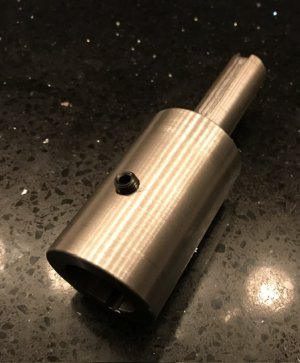I have a Causing 8511 with an M-head B&S #7. They are a little unusual as there isn't a right side table handle. My best guess it was a price point compromise.
I was ignorant and taken a little advantage of, it came with a Hitachi 3hp 3ph 56 frame on a poorly made angle plate adapter. In my ignorance I didn't think to just remove the motor or the head and paid for another lesson that resulted in a broken belt housing. The eBay replacement housing had been repaired and the stud isn't square with the housing. The replacement "Maybe it will be OK" metric motor shaft isn't and the step key for the pulley I had to make is getting worse (better??) at working it's way out.
So it's time to bite the bullet and do something about the motor.
Along the way I picked up another M-head, also B&S #7. I suspect it may have been one of the precision drill heads because it was being used as a drill press and the housing is taller with one more step in the pulley than my M-head. It also came with the original 1ph motor with a really heavy close tolerance cast iron integral base. Getting it on the belt housing isn't fun. And it won't go over the out of square stud on my belt housing.
I just hate the thought of grinding up the motor base, as easy of a fix as it would be. I'm not doing a good job convincing myself otherwise.
I can go through the spindle it came with, and just replace what I know works well M-head and hope. Being used as a drill press hopefully means it never saw any lateral forces and may be fine.
Or I can try again with a replacement motor. Finding one with the shaft length needed didn't go well last time, I'm not holding my breath this time will be any easier.
Thoughts on my rambling "Can't make up my mind?/ I'm still ignorant of a lot of things and am tired of expensive lesson."
I honestly don't care if the motor is 1 or 3ph. I figure people did good work with the pulleys, not going to get wrapped up about it. I have a RPC to live with the pulleys or I have a VFD if I decide to go that route.
Thoughts? And a last question. I have an original housing gasket and some bearings, purchased when H&W closed out their M-head parts. For proper oil flow, can someone tell me how the gasket is oriented? If there are oil flow holes in addition to the bolt holes, I'm not seeing them. I drip enough oil I known some is passing, but I've always had a nagging fear it's not as much as it should be.
And for what it's worth, I have figured out a simple jig and technique for getting the counter balance spring back in the well.


